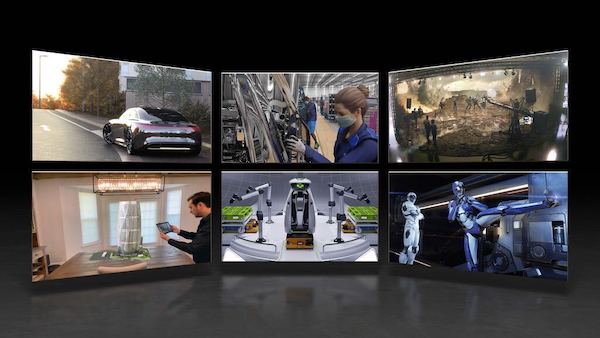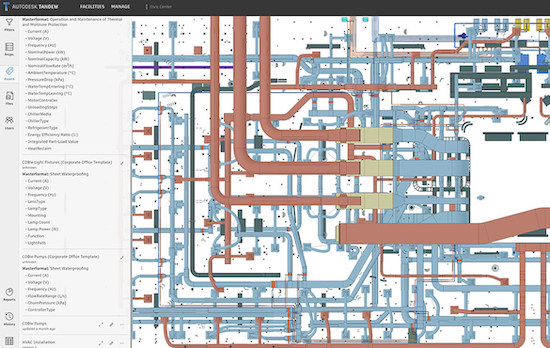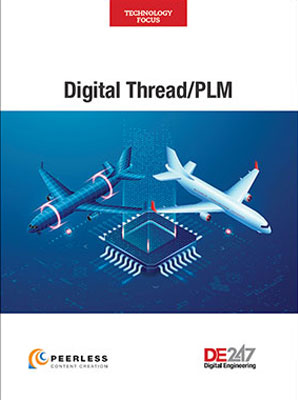Digital Twins Evolve in Manufacturing
Simulation, modeling, visualization and sensor-based data converge to close the design-to-manufacture loop.

NVIDIA Omniverse. Image courtesy of NVIDIA.
Latest News
October 15, 2021
While digital twin technology is still in the nascent stages of adoption, more and more manufacturing companies are launching programs to create and/or access virtual representations of the products, machines, and environments they design, manufacture or operate.
The convergence of advanced modeling and simulation, along with the explosion of network-connected devices and sensors in the real world, is accelerating this process. Deploying digital twins at scale remains a challenge, and organizations will need to be able to create and work with digital twins developed using a wide variety of tools, and do so in a way that enables virtual collaboration.
For organizations that want to incorporate digital twin technologies into their design, engineering, and manufacturing workflows, a number of organizational and cultural changes will be necessary to manage the collection and usage of digital twin data. The transition will also require new, interoperable software and hardware technologies that can accommodate those solutions.
The NVIDIA Omniverse platform has emerged as a way to provide the digital fabric necessary to build and collaborate using digital twins in both the manufacturing and architectural space. BMW Group, for example, is leveraging Omniverse for its factory of the future project.
“At NVIDIA we believe that a digital twin creates a fully simulated and shared world in a virtual space,” says Mike Geyer, Product Manager at NVIDIA. “It requires closed loop collaboration, and NVIDIA is really focused on being the company that closes that loop.”
Jerry Chen, Director of Global Business Development, Manufacturing & Industrials at NVIDIA, adds that a digital twin rests on three elements: original design intent (e.g. CAD), the ability to simulate the behavior of a system (e.g. CAE), and finally grounding these physics-based models with data-driven models created from sensor data captured from physical systems in the real world.
“A true twin takes all of those things into account,” Chen says. “The world needs to be able to condition the physics-based models we have typically relied on with the reality being captured by sensors in the field. Omniverse is a vehicle to fuse the data-driven and physics-based models together.”
Todd Edmunds, global CTO and strategic innovation/technology leader at Dell Technologies, says that Dell has both an internal and external digital twin initiative in place across its business units. The company is focusing on six areas, including creating a true foundational reference architecture for digital twins; securing digital twins across the network; creating global alliances with ISVs/GSIs and partners like NVIDIA to create an open infrastructure approach; developing new hardware and infrastructure products to support digital twin implementations; managing patents and intellectual property in a digital twin environment; and helping customers understand how they can benefit from the use of digital twins.
Edmunds says that there is a broad misunderstanding of what a digital twin is. “This is not just a digital image or a simulation of something,” Edmunds says. “It is not just a digital model, but one that represents that item in real time in the real world. You have to have real-time updating and synchronization as well as interoperability. If you have digital twins for different entities, how do they interface? You also need to be able to do simulations with those 3D models in real time, and visualize and consume the models in other applications.”
To that end, Dell has partnered with NVIDIA to leverage the Omniverse platform for connecting and exploring a variety of digital twins.
On the hardware front, Dell is creating new edge compute platforms, workstations, connectivity capabilities, high-performance computing (HPC) offerings, and hyperconverged infrastructure solutions that can support every aspect of digital twin implementation across the globe. For example, individual engineers will require high-performance workstations that include GPU-based acceleration in order to model and visualize those twins in real-time.
“As we add in some of the extra analytics and modeling, we will also need other types of acceleration,” he adds. “Not just GPUs but advanced accelerators made specifically for AI.”
Software solutions are emerging in the architecture, engineering and construction (AEC) space, as well as in manufacturing. In the manufacturing market, design and simulation software providers like Ansys, Siemens Digital Industries Software, PTC, and others have emerged in the engineering space. All of these companies have heavily leveraged NVIDIA GPU acceleration in their simulation, design and visualization tools.
In July 2021, Autodesk officially announced its cloud-based digital twin platform, Autodesk Tandem, for engineering and construction applications. Autodesk Tandem can gather all the information about a building, systems and equipment in both tabular and 3D representations. Building operators and facilities managers can then find the information they're looking for when responding to operational issues to keep proper maintenance. According to the company, Digital twins created in Autodesk Tandem are designed to improve operational efficiency and enable predictive maintenance to prevent disruptions and reduce operating costs.

In 2020, Autodesk also announced it was partnering with NVIDIA to leverage its Omniverse platform for collaborative design visualization. This was one of a number of partnerships that NVIDIA has formed to allow solutions vendors to integrate with Omniverse. Bentley Systems, for example, is using Omniverse to create a suite of applications on its digital iTwin platform. This would provide a graphics and compute pipeline for real-time visualization and simulation of infrastructure digital twins. Omniverse provides an open platform for working with models and data generated by a wide array of tools.
“Part of the challenge of digital twins is that someone creates a physical item, and they may use one application, and then that model has to be incorporated into different models from different vendors,” Edmunds says. “Having a platform that can simplify that and handle multiple different vendors with different CAD systems, and different models, and having a standardized way of representing those pieces, that is going to be really important. The company who makes the physical item is not going to be the same company operating it or even the same one who is providing real time information back into updating that 3D model.”
That is where the NVIDIA Omniverse comes in—by providing a physically-accurate, virtual space where models and data can be accessed regardless of origin. NVIDIA GPU acceleration helps drive these interactions through real-time visualization, simulation, machine learning and analysis.
Edge computing will also play a role in expanding digital twin applications, as connected devices will need more computing horsepower to manage and communicate data in real-time. Edmunds says that these edge platforms are evolving to include GPUs, AI chips, and other processing platforms. “As the definition of what is required in manufacturing changes, you will need more high-performance compute on the machine, and that may even include a bank of GPUs. Applications will need to leverage those GPUs as part of an elastic pool of compute on the factory floor.”
For example, an employee wearing AR or VR glasses could tap into those resources to troubleshoot machinery in real time.
According to Geyer at NVIDIA, a core philosophy of Omniverse is to help provide a neutral platform in which these use cases can emerge, because data can come from any source. We want to be complementary to existing tools. If we can facilitate a conversation between those tools and AIs using a common language like USD, that will solve a lot of problems for the industry.
More Dell Coverage

More NVIDIA Coverage
Subscribe to our FREE magazine, FREE email newsletters or both!
Latest News
Related Topics








